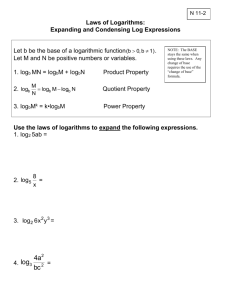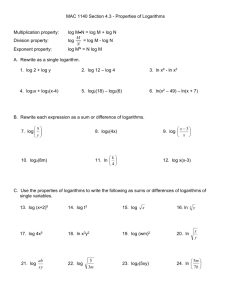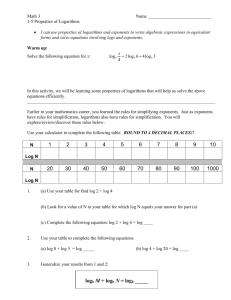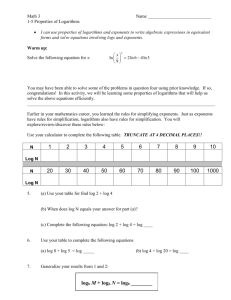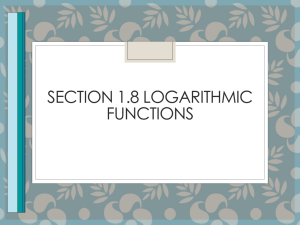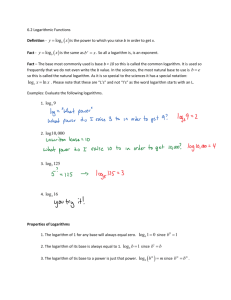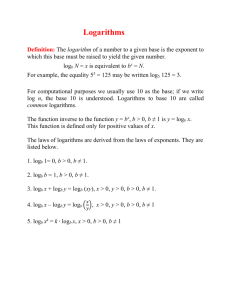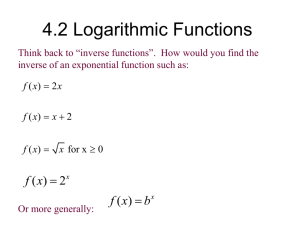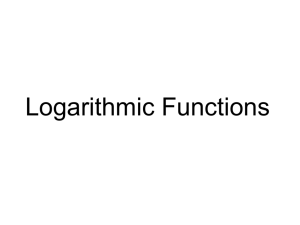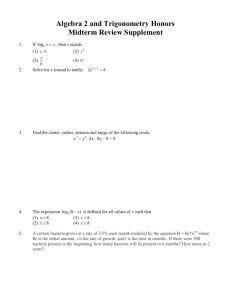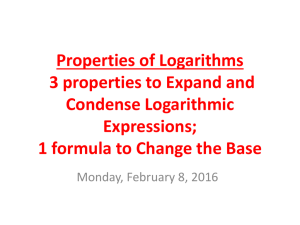160104 Logarithm meanings
advertisement
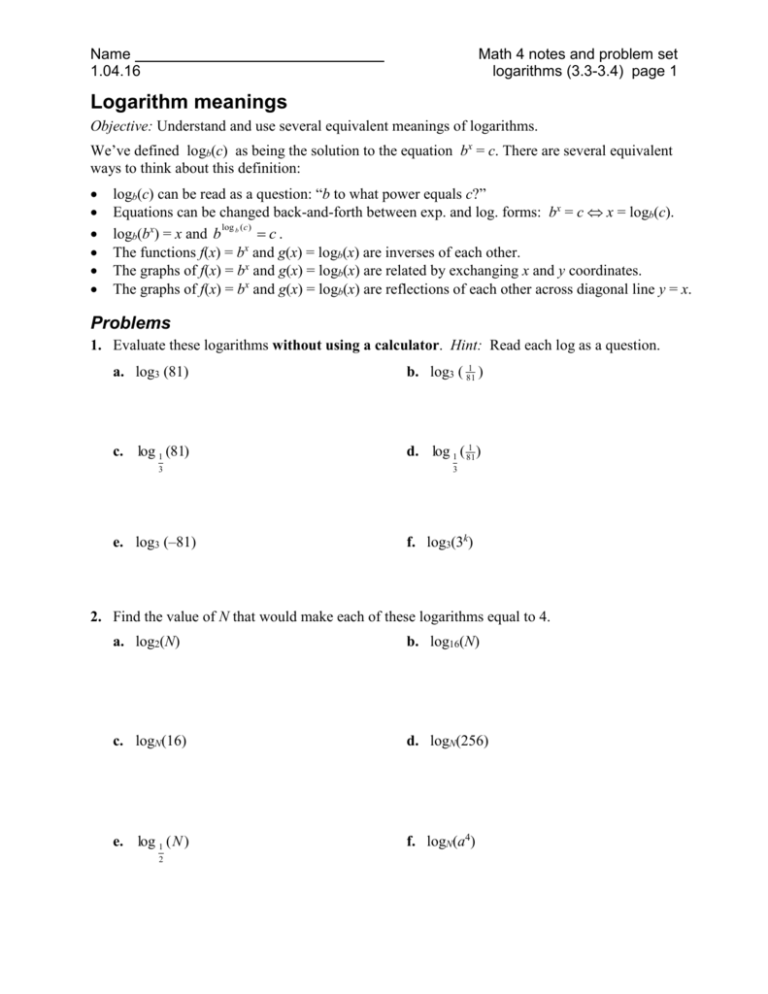
Name 1.04.16 Math 4 notes and problem set logarithms (3.3-3.4) page 1 Logarithm meanings Objective: Understand and use several equivalent meanings of logarithms. We’ve defined logb(c) as being the solution to the equation bx = c. There are several equivalent ways to think about this definition: logb(c) can be read as a question: “b to what power equals c?” Equations can be changed back-and-forth between exp. and log. forms: bx = c x = logb(c). log ( c ) logb(bx) = x and b b c . The functions f(x) = bx and g(x) = logb(x) are inverses of each other. The graphs of f(x) = bx and g(x) = logb(x) are related by exchanging x and y coordinates. The graphs of f(x) = bx and g(x) = logb(x) are reflections of each other across diagonal line y = x. Problems 1. Evaluate these logarithms without using a calculator. Hint: Read each log as a question. a. log3 (81) b. log3 ( 811 ) c. log 1 (81) d. log 1 ( 811 ) 3 e. log3 (–81) 3 f. log3(3k) 2. Find the value of N that would make each of these logarithms equal to 4. a. log2(N) b. log16(N) c. logN(16) d. logN(256) e. log 1 ( N ) f. logN(a4) 2 Name 1.04.16 Math 4 notes and problem set logarithms (3.3-3.4) page 2 For the next problem, you’ll need to know the following notations: log10(c) may be abbreviated as log(c). loge(c) may be abbreviated as ln(c). (e stands for the important irrational number e ≈ 2.71828, and “ln” is read “natural log.”) 3. Evaluate these logarithms without using a calculator. (Where the letter b appears, it stands for any positive number other than 1.) a. log5(125) b. logb (b5) c. log 1 ( 19 ) 3 d. log5 ( 3 5 ) e. log36 (6) f. log2 ( 321 ) g. log13 (13) h. log14 ( 141 ) i. logb ( b1 ) log 1 7 k. logb (bn) l. logb( b ) m. log(10000) n. log(0.000001) o. log(1) p. ln(e6) q. ln(e) r. ln ( 1e ) j. 7 4. Change each of these equations to the other form (either exponential or logarithmic). 17 2 = a. log2( 641 ) = –6 b. c. 3k = 47 d. logr(5) = t 1 49 Name 1.04.16 Math 4 notes and problem set logarithms (3.3-3.4) page 3 5. Change each of these equations to the other form (either exponential or logarithmic). You may need to use some algebraic steps other than the bx = c x = logb(c) step. Part a is completed as an example. a. 2 ∙ 3x = 7 b. 2 + log4(x) = 17 3x = 3.5 log3(3.5) = x c. 2000 ∙ (1.0234)x = 3000 d. log2 3x = 5 e. a ∙ (1.06)5 = 2000 d. 9 logw(7) = n 6. For each of the given functions, write a formula for its inverse function, then on a separate sheet of paper, sketch graphs of the pair of functions. (You may use your calculator to help with the graphs.) a. f(x) = 14 x b. f(x) = log2(x) Answers 1. a. 4, b. –4, c. –4, d. 4, e. undefined, f. k 2. a. 16, b. 65536, c. 2, d. 4, e. 3. a. 3, b. 5, c. 2, d. 13 , e. 4. a. 2–6 = 1 64 1 2 1 16 , f. a , f. –5, g. 1, h. –1, i. –1, j. –1, k. n, l. 12 , m. 4, n. –6, o. 0, p. 6, q. 1, r. –1 , b. log 1 491 2 , c. log3(47) = k, d. rt = 5 7 n 15 5 5. b. 4 = x, c. log1.0234(1.5) = x, d. 2 = 6. a. f –1(x) = log 1 ( x) , b. f –1(x) = 2x 4 x 3 or x = 3 ∙ 2 , e. log 5 2000 1.06 a ( ) = 5, f. w 9 7
